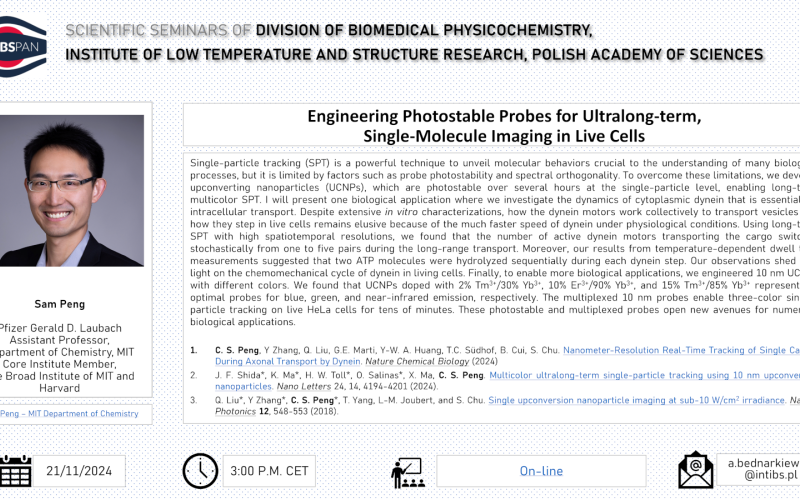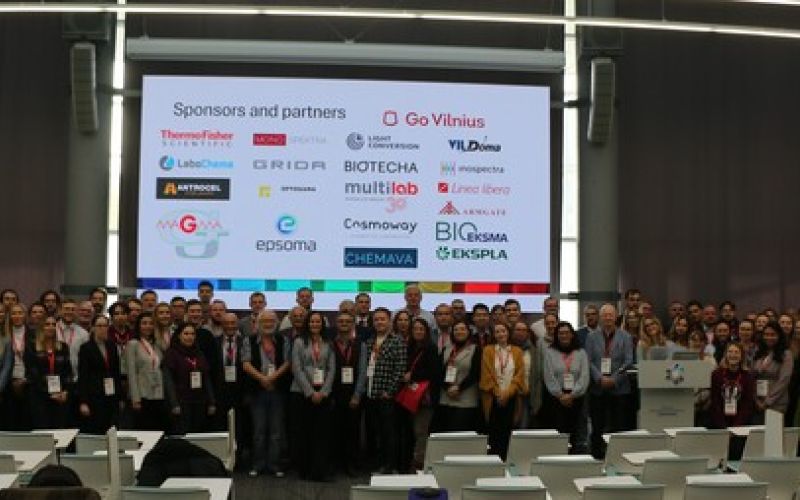Sensitized Photon Avalanche (SPA) - New NCN OPUS22 project
Profesor Bednarkiewicz has received a new NCN OPUS22 project entitled Sensitized Photon Avalanche Emission in lanthanide doped colloidal core-shell nanoparticles: novel materials for superresolution imaging (SPA). The project, with the buget of 2.46 mln PLN will last for 4 years.
In most of the luminescent materials emission intensity is proportional to excitation intensity. In such cases the emitted photons display energy that is lower than the energy of excitation photons. But there is a very interesting group of materials that does not follow these rules. In the latter group there are materials able to convert long wavelength radiation from near infrared region (NIR) to ultraviolet (UV) or visible (VIS) light in the process called photon up-conversion. There, emission intensity scales with power S=2,3,4 or even 5 of excitation intensity (e.g. 2,3,4 or 5 NIR photons are combined together to create one high energy photon in UV/Vis). Such luminescent materials, for example lanthanide doped nanoparticles, are very interesting for numerous applications in biology, because they offer background free sensitive bio-detection or bio-imaging. Lanthanides additionally display advantageous features, as they are characterized by narrow absorption and very stable multicolour emission which does not blink nor bleach like in many other fluorescent compounds. There is one another process, called photon avalanche (PA), which is a very specific type of up-conversion, where the power factor S goes beyond 10. In PA materials, minute changes of excitation intensity lead to rapid growth in emission intensity, for example doubling the pumping intensity increases over 100-fold the emission intensity. This phenomenon has been discovered in 1979 in praseodymium doped fluoride crystals, and since then some other lanthanide ions and other host materials showed the features of photon avalanche, mostly at cryogenic temperatures < 77K. The fact, the PA was observed only in bulk materials, such as single crystals, glasses or fibers limited their practical applications to up-converting lasers or to medium IR photons counters.
Recently, photon avalanche phenomenon has been demonstrated in nanomaterials at room temperature [1] using nanoparticles doped with thulium ions, which emitted NIR 800 nm light under 1064 nm excitation. This successful demonstration immediately suggested numerous biomedical application such as luminescent thermometry (i.e. optical signal quantifies temperature and enables temperature measurements or imaging under the microscope with micrometer resolution), ultrasensitive biosensing or imaging. The latter application is especially interesting, because it has ‘broken’ the fundamental limit of light diffraction, which has been known for decades to limit optical resolution of optical microscopes. Although some techniques have been developed for the so called super-resolution imaging (i.e. STED,PALM,STORM, SIM or their variants), most of these techniques require very complicated optical setups, powerful, tunable and costly femtosecond lasers, ultra-sensitive, costly detectors as well as specialized luminescent labels that photobleach easily. The photon avalanche super-resolution imaging with resolution of ca. 60-80 nm was demonstrated with very simple technical devices. Despite successful demonstration numerous challenges exist such as high pump threshold to see the avalanche photons (which so far require relatively powerful laser), slow appearance of luminescence (ca. 0.1s per pixel) limits imaging speed.
In the view of existing challenges to apply these highly perspective materials and ideas, current project will focus on two important and new aspects. Firstly, novel photon avalanche nanomaterials will be developed with enhanced properties. By co-doping PA core-shell nanomaterials with various lanthanide ions we plan to design and synthesize novel PA nanomaterials showing increased efficiency, lower threshold, faster response and multicolour emission. This will be achieved by a sequence of optimization steps, starting from theoretical modelling, selection of the best dopants types and their concentrations, followed by the synthesis of nanomaterials. These compounds will be versatilely characterized in terms of material properties (structure, morphology, composition) and spectral features (absorption and luminescence spectra and luminescence kinetics as a function of pumping intensity). Next, the most promising materials will be used to demonstrate multicolour super-resolution imaging. To make this demonstration, we plan to design and develop a new simple imaging instrument to enhance the speed of imaging, which will be achieved by creating an array of excitation spots on the sample and parallel recording of many places on the sample. Such approach should ultimately shorten the acquisition time of a single image frame.
Overall, the proposed progress in this truly interdisciplinary project should bring a few innovations. Firstly the photon avalanche process will be more deeply studied and understood from fundamental photo-physics perspective. Secondly, novel nanomaterials will be designed with enhanced features, which will be fine-tuned to show their prospects in super-resolution imaging. Finally, a new microscope will be designed to demonstrate the feasibility of super-resolution imaging with the new labels. These fundamental science and curiosity driven studies and work display a very strong application potential, because the super-resolution techniques have already helped biologists to understand functioning of living cells at the unprecedented level of details. The role of these methods and materials will surely grow in coming years to help biologists, biochemist and biotechnologist design new drugs and discover the origin of various sicknesses.
RELATED REFERENCES
- C. Lee, E. Xu, Y. Liu, A. Teitelboim, K. Yao, A. Fernandez-Bravo, A. Kotulska, S. Hwan Nam, Y. Doug Suh, A. Bednarkiewicz, B. E. Cohen, E. M. Chan, P. J. Schuck, Giant nonlinear optical responses from photon avalanching nanoparticles, Nature, 592 (2021) 7841
- A. Bednarkiewicz, M. Szalkowski, Photon avalanche in nanoparticles goes multicolour, News&Views, Nature Nanotechnology, (2022) .
- M. Szalkowski, M. Dudek, Z. Korczak, C. Lee, L. Marciniak, E. M. Chan, P. J. Schuck, A. Bednarkiewicz, Predicting the impact of temperature dependent multi-phonon relaxation processes on the photon avalanche behavior in Tm3+ : NaYF4 nanoparticles, Opt Mater X 12 (2021) 100102.
- A. Bednarkiewicz, E. Chan, K. Prorok, Enhancing FRET biosensing beyond 10 nm with photon avalanche nanoparticles, Nanoscale Adv. 2 (2020) 4863-4872.



